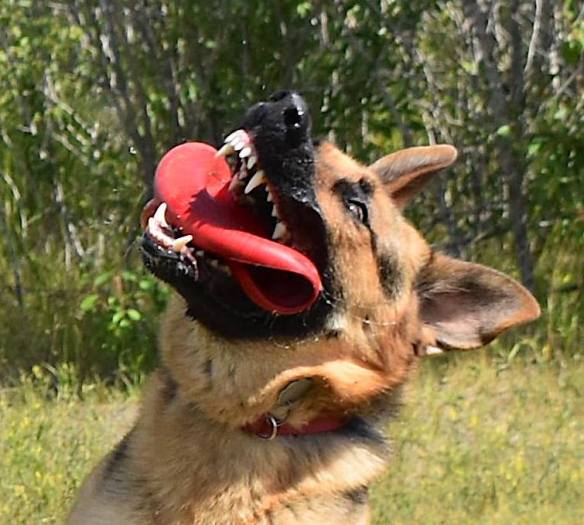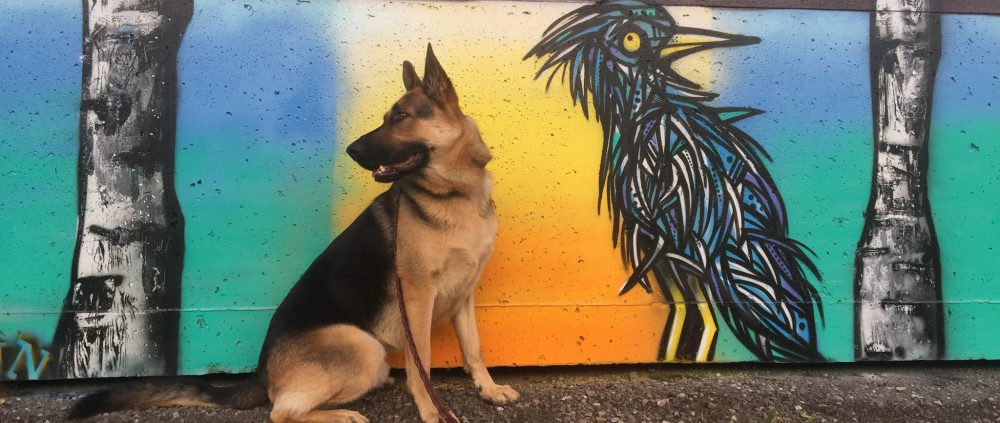The woman walked straight up to Milo and me, grabbed Milo by the fur on both sides of his head, kissed him on the nose, and nuzzled his head with her face. That’s right, with her face.
Of all the dumbass things to do…

Raise your hand if you think it’s a good idea to grab this guy by the head and rub your face on his nose.
If I freaked out, it could have been the match that set off that powder keg, so I shoved a handful of liver treats in Milo’s maw and chirped, “OK, that’s enough cuddling.”
The woman backed off with her face still attached to her skull while Milo concentrated on getting all of that liver out from between his molars—it was a big handful of treats—and all was well.
Think about the fight or flight response. When a dog is on a leash, flight is not an option. This is one of the reasons why some dogs act more aggressively when they’re on a leash than when they aren’t.
Never approach a dog when they don’t have the option of saying “no thanks” and leaving. It is about respect, and consent, and common sense.
Ideally, if you meet Milo and me on a walk and you want to say hello to him, the scene plays itself out in one of these ways:
Scenario 1
You: “Can I pet your dog?”
Me: “Not today, thank you for asking.”
And Milo and I walk on.
When this happens, don’t give us the stink eye, because you know what? Although there are lots of reasons why we may not want to interact with you, neither he nor I have to give you a reason. I always appreciate it when people ask rather than, say, walk up and grab Milo’s face. But, if you ask and give us one bit of grief for saying “no,” you aren’t really asking. That is not cool.
Scenario 2
You: “Can I pet your dog?”
Me: “Milo sit” (with me between him and you).
Me some more: “Thank you for asking. Let’s see if he wants to say hello. If, when I release him he walks up to you, you can scratch him under the chin or on the side of his body.”
Me, to the dog this time: “Milo, would you like to say hello?”This scenario can end in two ways:
Ending a: If Milo wags his tail and walks over to you, you get to share some personal time together.
Ending b: If Milo doesn’t happily walk up to you, I’ll say, “I guess not today. Thanks again for asking.” And Milo and I walk on.
In an ideal world if you and Milo interact, three of us—you, me, and Milo—all have to consent.
I won’t let him go bounding up to you and sniff your crotch or demand to be petted, and I won’t let you pet him if I don’t want you to and if he doesn’t want you to. The interaction will start when he walks up to you, and it will end when any one of the three of us wants it to. He tells us that he wants it to end by moving away. Milo is more fun and makes friends faster when he gets to consent.
If you want to pet a dog, but you’re wondering what doggie consent looks like, I recommend that you go over to Sara Reusche’s post at Paws Abilities. She gives a great step-by-step description of how to determine if a dog consents, and continues to give consent, to a social interaction.
This way everyone gets treated with respect, and everyone stays safe.

Thanks for writing this, Carla! I’ve been reflecting more often recently on what it means for animals such as Milo to give consent. I also admit to some quick, guilty mental review as to whether or not I met Milo in an unethical way, but I hope I didn’t — in my memory, he jogged right up to me and stuck his nose in my face. 😀 What a sweetie. I hope I conducted myself rightly and respectfully in his direction, but I could not resist telling him he was awesome and rubbing his face and head.
LikeLike
Kate, I can’t imagine you not acting rightly in this case. What I didn’t write much about above is my job to ensure that the other person in this interaction consents to meet Milo. Most of the time he is very social and wants to say hello. If he walks up to you with a wagging tail and pokes you with his nose he is enthusiastically consenting, and possibly rudely demanding, affection.
animal consent has been on my mind these days too. It is a reoccurring topic in my class, Animals in our Lives.
LikeLike
Yes yes yes!!!!! Same goes is if you have a dog with you and you want to say hi to me and my dog. Just yesterday I yelled at a man to get his dog away after the man repeatedly ignored all social indicators that neither I nor my dogs wanted anything to do with him and his dog that was at the end of the flexi lead stalking us. I was so mad! Recently I had an interaction with a random woman about asking, she said “oh because he’s a working guide dog” and I replied “no because it’s basic safety” and it was like the thought hasn’t occurred to her until I said it that “oh duh, dogs have teeth and I should always ask”. It always amazes me the bite incidents aren’t higher, dogs are so forgiving of our indiscretions so very often. Good boy Milo and I’m so glad he has such a good advocate at the end of his leash.
LikeLike
I’m amazed that more people don’t get bitten too. Dogs are amazingly forgiving and generous creatures.
LikeLiked by 1 person
This is important information for everyone to consider: consent is everything, whether dog or person 🙂
LikeLiked by 1 person
Thank you! I have to admit that I put off writing this post for a while because I want to be respectful of discussions of consent and sex. I am still thinking about that connection, but right now it seems to me that it is a very good thing not to assume that we are entitled to any creature’s affections or bodies.
LikeLiked by 1 person
I think we’re in the midsts of many healthy and uncomfortable conversations, but any discussion, difficult or not, that comes with helpful dos and don’ts puts us that much further ahead 🙂
LikeLike
What a great article! Consent is so important, whether it’s human or furry. Speaking of furries, fursuiters sometimes experience challenges with consent whilst in their fursuits. Want to get close? Ask! Everyone (including our furry friends) deserve respect and the option to accept or decline contact. Great piece!
LikeLiked by 2 people
Thank you!
LikeLike
Actually, come to think of it…people often, probably purely unconsciously (or at least without malicious intent) treat dogs, especially when they find them “cute” or “adorable” or just “love animals so much,” like babies or small children. Adults tend to overstep boundaries, especially physically when they find them “cute” in a juvenile sort of way…I’ll bet you anything the person in your anecdote would also run up and squeeze a baby’s cheeks or place her hand on a pregnant woman’s belly without asking. I think some people feel a sense of entitlement when they feel overwhelmed by the “cute” factor.
LikeLiked by 1 person
Important important subject area. One thing I have been trying to teach my younger sister (3 years old) is that when the rats “squeak” or “squirm” they do not want to be held. For me it’s important to teach her this so that she let’s them go. For rats, in particular, I have found that the only way to earn there trust is to listen to these particular cues. And when they trust that their space will be respected they are SOOO much more loving. Ironic. Consent is definitely something that should be discussed in relation to the furry world.
Service-dogs come to mind as a starting point to help people learn consent in relation to animals. I myself have become more respectful of animals sense of space since interacting with/ and learning more about therapy dogs (and other service dogs). People of course still manage to neglect the “ask first” policy of service dogs, but I think their professional distinction could aid in consent for animals.
Wild animals, too. Wild animals are great at telling us that we need to respect their space. They often provide more forgiving chances, as well. i.e. they move back, then they growl, then they fluff or stand up or open wings (depending on creature), and only when they decide they need to attack, do they attack. They are much more forgiving then humans. Geese, are a great example. They DEMAND respect for their space. On the flip side, I have seen the gentle side of geese, and other animals when I have respected their limits, and slowly earned their trust. That is when you experience the true gentleness of animals. Respect, trust, and boundaries. It’s a good foundation for any relationship.
Thank you for this post. It is something thought-provoking to thing about.
LikeLike
Wow, what a potentially horrifying situation — quick thinking with the treats! You’re such a great mom. 😊 (As an aside, you’ve helped me articulate one of the reasons I don’t like the term “pet” — animals are not property, they’re our companions. And they should be respected as such.)
LikeLike